Showing Spotlights 113 - 120 of 338 in category All (newest first):
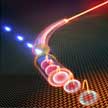 In recent years, all-optical modulators (AOMs) have attracted significant interests due to their low power consumption, broad bandwidth, and potential in all-optical fields. Among these, AOMs based on the high photothermal efficiency of antimonene, exhibit remarkable advantages for their large modulation depth, wide operating wavelength range, and easy implementation.
Researchers demonstrated that an antimonene-based AOM was successfully utilized to actively Q-switch a fiber laser in a fully photonics domain and this actively modulated laser represented all-optically tunable output parameters, and easy time synchronization.
In recent years, all-optical modulators (AOMs) have attracted significant interests due to their low power consumption, broad bandwidth, and potential in all-optical fields. Among these, AOMs based on the high photothermal efficiency of antimonene, exhibit remarkable advantages for their large modulation depth, wide operating wavelength range, and easy implementation.
Researchers demonstrated that an antimonene-based AOM was successfully utilized to actively Q-switch a fiber laser in a fully photonics domain and this actively modulated laser represented all-optically tunable output parameters, and easy time synchronization.
Mar 15th, 2019
 Electronic tattoos (e-tattoos) are an extremely thin form of wearable electronics. They are lightweight and soft, which allows them to be intimately mounted on human skin for noninvasive, high-fidelity sensing. During the operation of e-tattoos, they are constantly exposed to external mechanical inputs such as bending, twisting, pressing, and cutting, which may cause mechanical damage and lead to malfunction. Now, researchers have demonstrated a self-healing silk e-tattoo that shows high sensitivity to multiple stimuli, including strain, humidity, and temperature based on a unique graphene, silk fibroin, Ca2+ combination.
Electronic tattoos (e-tattoos) are an extremely thin form of wearable electronics. They are lightweight and soft, which allows them to be intimately mounted on human skin for noninvasive, high-fidelity sensing. During the operation of e-tattoos, they are constantly exposed to external mechanical inputs such as bending, twisting, pressing, and cutting, which may cause mechanical damage and lead to malfunction. Now, researchers have demonstrated a self-healing silk e-tattoo that shows high sensitivity to multiple stimuli, including strain, humidity, and temperature based on a unique graphene, silk fibroin, Ca2+ combination.
Mar 8th, 2019
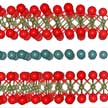 Potassium niobate (KNbO3) is a a perovskite ferroelectric crystal that, due to its optical properties, has been found useful in many different areas of materials science research, including electro-optics, piezoelectric, and electronic applications. Researchers have now, for the first time, succeeded in producing large KNbO3 crystals with uniform flat shape, and c-axis texture, which makes the crystals useful for practical electro-optic applications. By using MXenes as precursor materials to grow ferroelectric crystals, their 2D nature is inherited by the ferroelectric crystals.
Potassium niobate (KNbO3) is a a perovskite ferroelectric crystal that, due to its optical properties, has been found useful in many different areas of materials science research, including electro-optics, piezoelectric, and electronic applications. Researchers have now, for the first time, succeeded in producing large KNbO3 crystals with uniform flat shape, and c-axis texture, which makes the crystals useful for practical electro-optic applications. By using MXenes as precursor materials to grow ferroelectric crystals, their 2D nature is inherited by the ferroelectric crystals.
Feb 25th, 2019
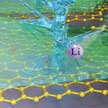 The formation of dendrites on the metal electrodes of lithium metal batteries causes safety and performance concerns. To avoid dendrites, researchers are experimenting with new battery electrolyte chemistries, new separator technologies, and new physical hosts for the lithium metal. Researchers now have discovered a key design rule for Li metal batteries: If you want to suppress dendrites, you have to use a defect-free host. More generally, carbon defects catalyze dendrite growth in metal anodes.
The formation of dendrites on the metal electrodes of lithium metal batteries causes safety and performance concerns. To avoid dendrites, researchers are experimenting with new battery electrolyte chemistries, new separator technologies, and new physical hosts for the lithium metal. Researchers now have discovered a key design rule for Li metal batteries: If you want to suppress dendrites, you have to use a defect-free host. More generally, carbon defects catalyze dendrite growth in metal anodes.
Feb 13th, 2019
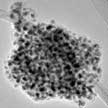 Researchers report significant advances in developing a high-temperature, fast nanomanufacturing technique for the large-scale production of ultra small metal nanoclusters decorated in a graphene host matrix. The size and morphology of the metal nanoclusters can be controlled by varying the reaction temperature and the mass loading of metal salt in the graphene aerosol nanoreactors. This one-step continuous aerosol-based thermal shock technique offers considerable potential for the manufacturing of well-dispersed and uniform nanoclusters stabilized within a host matrix.
Researchers report significant advances in developing a high-temperature, fast nanomanufacturing technique for the large-scale production of ultra small metal nanoclusters decorated in a graphene host matrix. The size and morphology of the metal nanoclusters can be controlled by varying the reaction temperature and the mass loading of metal salt in the graphene aerosol nanoreactors. This one-step continuous aerosol-based thermal shock technique offers considerable potential for the manufacturing of well-dispersed and uniform nanoclusters stabilized within a host matrix.
Feb 4th, 2019
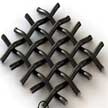 Motivated by the high level of flexibility exhibited by spider webs, scientists have developed a novel design for highly flexible and sensitive piezoresistive sensors based on an elastomer-filled graphene-woven fabric (E-GWF) structure. This technique mimics the distinct core-shell structure of spider webs. This fabrication method could also be extended to other 1D and 2D materials for many emerging practical applications. In addition to excellent sensing capability, the E-GWF also shows unusual switching behavior at large strains owing to the reversible cracking and reconnection of interconnected graphene tubes.
Motivated by the high level of flexibility exhibited by spider webs, scientists have developed a novel design for highly flexible and sensitive piezoresistive sensors based on an elastomer-filled graphene-woven fabric (E-GWF) structure. This technique mimics the distinct core-shell structure of spider webs. This fabrication method could also be extended to other 1D and 2D materials for many emerging practical applications. In addition to excellent sensing capability, the E-GWF also shows unusual switching behavior at large strains owing to the reversible cracking and reconnection of interconnected graphene tubes.
Jan 17th, 2019
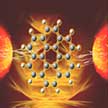 Sluggish electron transport kinetics - also known as aging - has hindered the application of graphene, for example, as transparent photodiode sensors in optoelectronics, graphites for effective use as oxygen reducing agents in fuel cells and so many other applications that involve fast heterogeneous electron transport and even increased capacitance. Scientists now report a breakthrough solution to the oxidation-induced sluggish electron transport in graphite (and even graphene).
Sluggish electron transport kinetics - also known as aging - has hindered the application of graphene, for example, as transparent photodiode sensors in optoelectronics, graphites for effective use as oxygen reducing agents in fuel cells and so many other applications that involve fast heterogeneous electron transport and even increased capacitance. Scientists now report a breakthrough solution to the oxidation-induced sluggish electron transport in graphite (and even graphene).
Jan 8th, 2019
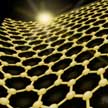 Due to their excellent electron-transport properties and extremely high carrier mobility, graphene and other other direct bandgap monolayer materials such as transition-metal dichalcogenides (TMDCs) and black phosphorus show great potential to be used for low-cost, flexible, and highly efficient photovoltaic devices. A recent review provides a comprehensive overview on the current state-of-the-art of 2D-materials-based solar photovoltaics. It describes the recent progress made with graphene, graphene-based materials, and other 2D materials for solar photovoltaics, including silicon-based solar cells, and organic and perovskite solar cells.
Due to their excellent electron-transport properties and extremely high carrier mobility, graphene and other other direct bandgap monolayer materials such as transition-metal dichalcogenides (TMDCs) and black phosphorus show great potential to be used for low-cost, flexible, and highly efficient photovoltaic devices. A recent review provides a comprehensive overview on the current state-of-the-art of 2D-materials-based solar photovoltaics. It describes the recent progress made with graphene, graphene-based materials, and other 2D materials for solar photovoltaics, including silicon-based solar cells, and organic and perovskite solar cells.
Jan 7th, 2019
 In recent years, all-optical modulators (AOMs) have attracted significant interests due to their low power consumption, broad bandwidth, and potential in all-optical fields. Among these, AOMs based on the high photothermal efficiency of antimonene, exhibit remarkable advantages for their large modulation depth, wide operating wavelength range, and easy implementation.
Researchers demonstrated that an antimonene-based AOM was successfully utilized to actively Q-switch a fiber laser in a fully photonics domain and this actively modulated laser represented all-optically tunable output parameters, and easy time synchronization.
In recent years, all-optical modulators (AOMs) have attracted significant interests due to their low power consumption, broad bandwidth, and potential in all-optical fields. Among these, AOMs based on the high photothermal efficiency of antimonene, exhibit remarkable advantages for their large modulation depth, wide operating wavelength range, and easy implementation.
Researchers demonstrated that an antimonene-based AOM was successfully utilized to actively Q-switch a fiber laser in a fully photonics domain and this actively modulated laser represented all-optically tunable output parameters, and easy time synchronization.
 Subscribe to our Nanotechnology Spotlight feed
Subscribe to our Nanotechnology Spotlight feed





